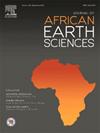博茨瓦纳东部土壤和岩石的磁滞和热磁特性
IF 2.2
4区 地球科学
Q2 GEOSCIENCES, MULTIDISCIPLINARY
引用次数: 0
摘要
岩石磁性是各种应用的组成部分,包括古地磁、板块构造、地质解释、地质勘探、采矿、法医和工程。这项研究建立在之前对博茨瓦纳东部土壤磁化率的研究基础上,重点关注关键的磁性参数,如在氮气气氛中测定的居里温度(Tc)和磁滞变量(矫顽力:Hc,矫顽力:Hcr,饱和剩磁磁化:Mrs,饱和磁化:Ms)。从室温到700°C测量的热磁曲线有助于磁矿物学和粒度学的分类。结果显示存在磁性矿物,如赤铁矿、磁铁矿和磁黄铁矿,居里温度分别约为600℃、580℃和200℃。磁滞回线进一步支持了土壤样品中类磁铁矿相的优势。磁滞和热磁数据都表明,磁铁矿是造成磁学性质的主要因素。值得注意的是,对Ramatlabama至Ramokgwebana横断面(横跨Kaapvaal克拉通、林波波带和津巴布韦克拉通)土壤的热磁分析为划定这些克拉通区域和相关造山带的边界提供了可能。因此,将研究范围扩大到不同的地形和地质环境将进一步加强我们对地壳过程和磁性矿物分布的理解,这对地质建模和勘探原材料矿床是非常宝贵的。本文章由计算机程序翻译,如有差异,请以英文原文为准。
Hysteresis and thermomagnetic characteristics of soils and rocks in eastern Botswana
Rock magnetic properties are integral to various applications, including palaeomagnetism, plate tectonics, geological interpretation, geoexploration, mining, forensics, and engineering. This study builds upon previous research on the magnetic susceptibilities of soils in eastern Botswana, focusing on key magnetic parameters such as the Curie temperature (Tc), determined in a nitrogen atmosphere, and hysteresis variables (coercive force: Hc, coercive remanence: Hcr, saturation remanence magnetisation: Mrs, saturation magnetisation: Ms). Thermomagnetic curves, measured from room temperature up to 700 °C, facilitated the classification of magnetic mineralogy and granulometry.
Results
reveal the presence of magnetic minerals such as hematite, magnetite, and pyrrhotite, with Curie temperatures approximately at 600 °C, 580 °C, and 200 °C, respectively. Hysteresis loops further support the dominance of magnetite-like phases in the soil samples. Both hysteresis and thermomagnetic data suggest magnetite as the primary contributor to the magnetic properties. Notably, thermomagnetic analyses of soils along the Ramatlabama to Ramokgwebana transect—crossing the Kaapvaal Craton, Limpopo Belt, and Zimbabwe Craton—offer potential for delineating the boundaries of these cratonic regions and associated orogenic belts. Thus, expanding research coverage across different terrains and geological settings would further enhance our understanding of crustal processes and magnetic mineral distributions invaluable for geological modelling and exploration for raw material deposits.
求助全文
通过发布文献求助,成功后即可免费获取论文全文。
去求助
来源期刊

Journal of African Earth Sciences
地学-地球科学综合
CiteScore
4.70
自引率
4.30%
发文量
240
审稿时长
12 months
期刊介绍:
The Journal of African Earth Sciences sees itself as the prime geological journal for all aspects of the Earth Sciences about the African plate. Papers dealing with peripheral areas are welcome if they demonstrate a tight link with Africa.
The Journal publishes high quality, peer-reviewed scientific papers. It is devoted primarily to research papers but short communications relating to new developments of broad interest, reviews and book reviews will also be considered. Papers must have international appeal and should present work of more regional than local significance and dealing with well identified and justified scientific questions. Specialised technical papers, analytical or exploration reports must be avoided. Papers on applied geology should preferably be linked to such core disciplines and must be addressed to a more general geoscientific audience.
 求助内容:
求助内容: 应助结果提醒方式:
应助结果提醒方式:


